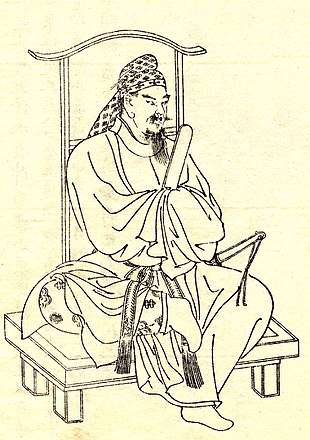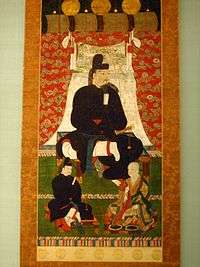Fujiwara no Kamatari
| Fujiwara no Kamatari | |
|---|---|
 An illustration of Fujiwara no Kamatari by Kikuchi Yōsai | |
| Native name | 藤原 鎌足 |
| Born |
Nakatomi no Kamatari 614 |
| Died | November 14, 669 |
| Known for | Founder of the Fujiwara clan, launched the Taika Reform of 645 with Naka no Ōe (later Emperor Tenji) |
| Notable work | Poems in the Man'yōshū and Kakyō Hyōshiki |
| Opponent(s) | Soga clan |
| Spouse(s) | Kagami no Ōkimi |
| Children | Jōe, Fujiwara no Fuhito, Hikami no Ōtoji, Ōhara no Ōtoji, Mimi no Toji |
| Parent(s) | Nakatomi no Mikeko, |
Fujiwara no Kamatari (藤原 鎌足, 614 – November 14, 669) was a Japanese statesman, courtier and politician during the Asuka period (538–710).[1] Kamatari was born to the Nakatomi clan and became the founder of the Fujiwara clan.[2] He, along with the Mononobe clan, was a supporter of Shinto and fought the introduction of Buddhism to Japan. The Soga clan, defenders of Buddhism in the Asuka period, defeated Kamatari and the Mononobe clan and Buddhism became the dominant religion of the imperial court. Kamatari, along with Prince Naka no Ōe, later Emperor Tenji (626–672), launched the Taika Reform of 645, which centralized and strengthened the central government. Just before his death he received the honorific of Taishōkan (or Daishokukan) and the surname Fujiwara from the Emperor Tenji, thus establishing the Fujiwara clan.[3][4]
Biography
Kamatari was born to the Nakatomi clan, was the son of Nakatomi no Mikeko, and named Nakatomi no Kamatari (中臣 鎌足) at birth.[3] He was a friend and supporter of the Prince Naka no Ōe, later Emperor Tenji. Kamatari was the head of the Jingi no Haku, or Shinto ritualists; as such, he was one of the chief opponents of the increasing power and prevalence of Buddhism in the court, and in the nation. As a result, in 645, Prince Naka no Ōe and Kamatari made a coup d'état in the court. They slew Soga no Iruka who had a strong influence over Empress Kōgyoku; thereafter, Iruka's father, Soga no Emishi, committed suicide.
Empress Kōgyoku was forced to abdicate in favor of her younger brother, who became Emperor Kōtoku; Kōtoku then appointed Kamatari naidaijin (内大臣, Inner Minister).
Kamatari was a leader in the development of what became known as the Taika Reforms, a major set of reforms based on Chinese models and aimed at strengthening Imperial power.[3] He acted as one of the principal editors responsible for the development of the Japanese legal code known as Sandai-kyaku-shiki, sometimes referred to as the Rules and Regulations of the Three Generations.[5]
During his life Kamatari continued to support Prince Naka no Ōe, who became Emperor Tenji in 661. Tenji granted him the highest rank Taishōkan (or Daishokukan) (大織冠) and a new clan name, Fujiwara (藤原), as honors.[3]
Legacy
Kamatari's son was Fujiwara no Fuhito. Kamatari's nephew, Nakatomi no Omimaro became head of Ise Shrine, and passed down the Nakatomi name.
In the 13th century, the main line of the Fujiwara family split into five houses: Konoe, Takatsukasa, Kujō, Nijō and Ichijō. These five families in turn provided regents for the Emperors, and were thus known as the Five Regent Houses. The Tachibana clan (samurai) also claimed descent from the Fujiwara. Emperor Montoku of the Taira clan was descended through his mother to the Fujiwara.
Until the marriage of the Crown Prince Hirohito (posthumously Emperor Shōwa) to Princess Kuni Nagako (posthumously Empress Kōjun) in January 1924, the principal consorts of emperors and crown princes had always been recruited from one of the Sekke Fujiwara. Imperial princesses were often married to Fujiwara lords - throughout a millennium at least. As recently as Emperor Shōwa's third daughter, the late former Princess Takanomiya (Kazoku), and Prince Mikasa's elder daughter, the former Princess Yasuko, married into Takatsukasa and Konoe families, respectively. Empress Shōken was a descendant of the Fujiwara clan and through Hosokawa Gracia of the Minamoto clan. Likewise a daughter of the last Tokugawa Shogun married a second cousin of Emperor Shōwa.

Among Kamatari's descendants are Fumimaro Konoe the 34th/38th/39th Prime Minister of Japan and Konoe's grandson Morihiro Hosokawa the 79th Prime Minister of Japan (who is also a descendant of the Hosokawa clan via the Ashikaga clan of the Minamoto clan).
Family
- Father: Nakatomi no Mikeko (中臣御食子)
- Mother: Ōtomo no Chisen-no-iratsume (大伴智仙娘), daughter of Otomo no Kuiko (大伴囓子). Also known as "Ōtomo-bunin" (大伴夫人).
- Main wife: Kagami no Ōkimi (鏡王女, ?-683)
- Wife: Kurumamochi no Yoshiko-no-iratsume (車持与志古娘), daughter of Kurumamochi no Kuniko (車持国子).
- 1st son: Jōe (定恵, 643–666), buddhist monk who traveled to China.
- 2nd son: Fujiwara no Fuhito (藤原不比等, 659–720)
- Children with unknown mother:
- Daughter: Fujiwara no Hikami-no-iratsume (藤原氷上娘, ?–682), Bunin of Emperor Tenmu, mother of Princess Tajima.
- Daughter: Fujiwara no Ioe-no-iratsume (藤原五百重娘), Bunin of Emperor Tenmu, wife of Fujiwara no Fuhito and mother of Prince Niitabe and Fujiwara no Maro.
- Daughter: Fujiwara no Mimimotoji (藤原耳面刀自), Bunin of Emperor Kōbun, mother of Princess Ichishi-hime (壱志姫王).
- Daughter: Fujiwara no Tome/Tone-no-iratsume (藤原斗売娘), wife of Nakatomi no Omimaro (中臣意美麻呂), mother of Nakatomi no Azumahito (中臣東人).
Popular culture
- Portrayed by Noh Seung-jin in the 2012-2013 KBS1 TV series The King's Dream.
See also
- Tōshi Kaden, a bibliographic record
Notes
- ↑ Nussbaum, Louis-Frédéric. (2005). "Fujiwara no Tadahira" in Japan Encyclopedia, p. 203, p. 203, at Google Books; Brinkley, Frank et al. (1915). A History of the Japanese People from the Earliest Times to the End of the Meiji Era, p. 203., p. 203, at Google Books
- ↑ Ponsonby-Fane, Richard. (1962). Sovereign and Subject, pp. 216-220.
- 1 2 3 4 "Fujiwara no Kamatari". Encyclopedia of Japan. Tokyo: Shogakukan. 2012. OCLC 56431036. Archived from the original on 2007-08-25. Retrieved 2012-10-27.
- ↑ "藤原 鎌足" [Fujiwara no Kamatari]. Dijitaru Daijisen (in Japanese). Tokyo: Shogakukan. 2012. OCLC 56431036. Archived from the original on 2007-08-25. Retrieved 2012-10-27.
- ↑ Brinkley, p. 177., p. 177, at Google Books
References
- Brinkley, Frank and Dairoku Kikuchi. (1915). A History of the Japanese People from the Earliest Times to the End of the Meiji Era. New York: Encyclopædia Britannica. OCLC 413099
- Nussbaum, Louis-Frédéric and Käthe Roth. (2005). Japan encyclopedia. Cambridge: Harvard University Press. ISBN 978-0-674-01753-5; OCLC 58053128
- Titsingh, Isaac. (1834). Nihon Ōdai Ichiran; ou, Annales des empereurs du Japon. Paris: Royal Asiatic Society, Oriental Translation Fund of Great Britain and Ireland. OCLC 5850691
- 1 2 3 Brinkley, Frank and Dairoku Kikuchi. (1915). A History of the Japanese People from the Earliest Times to the End of the Meiji Era. New York: Encyclopædia Britannica. OCLC 413099
- 1 2 3 4 5 Kanai, Madoka; Nitta, Hideharu; Yamagiwa, Joseph Koshimi (1966). A topical history of Japan. Sub-Committee on Far Eastern Language Instruction of the Committee on Institutional Cooperation. p. 6.
- 1 2 Brown, Delmer M. (1988). The Cambridge History of Japan: Volume 1. Cambridge University Press. ISBN 9780521223522.
- 1 2 平城宮兵部省跡. 奈良文化財研究所. 2005. p. 168.
- ↑ Yoshikawa, Toshiko (2006). 仲麻呂政権と藤原永手・八束(真楯)・千尋(御楯). Hanawa Shobō (塙書房). ISBN 978-4-8273-1201-0.
- ↑ Tyler, Royall (1993). The Book of the Great Practice": The Life of the Mt. Fuji Ascetic Kakugyō Tōbutsu Kū (PDF). Asian Folklore Studies. p. 324.
- ↑ Yoneda, Yūsuke (2002). 藤原摂関家の誕生. 吉川弘文館. p. 139.
- ↑ Nakagawa, Osamu (1991). "藤原良継の変" [The Rise of Fujiwara no Yoshitsugu]. 奈良朝政治史の研究 [Political History of the Nara Period] (in Japanese). Takashina Shoten (高科書店).
- ↑ Kimoto, Yoshinobu (1998). 藤原式家官人の考察. 高科書店. p. 47. ISBN 978-4-87294-923-0.
- ↑ Takemitsu, Makoto (2013). 日本史の影の主役藤原氏の正体: 鎌足から続く1400年の歴史. PHP研究所. p. 103. ISBN 978-4569761046.
- ↑ http://www.asahi-net.or.jp/~sg2h-ymst/hamanari.html
- 1 2 3 4 5 6 7 8 9 10 Nussbaum, Louis-Frédéric. (2005). In Japan Encyclopedia at Google Books; Brinkley, Frank et al. (1915).
- ↑ Kimoto, Yoshinobu (2004). "『牛屋大臣』藤原是公について" [On "Ushiya-Daijin" Fujiwara no Korekimi]. 奈良時代の藤原氏と諸氏族 [The Fujiwara Clan and Other Clans of the Nara Period] (in Japanese). Ohfu.
- ↑ Kurihara, Hiromu. 藤原内麿家族について [The Family of Fujiwara no Uchimaro]. Japanese History (日本歴史) (in Japanese) (511).
- ↑ Kurihara, Hiromu (2008). "藤原冬嗣家族について" [Fujiwara no Fuyutsugu's Family]. 平安前期の家族と親族 [Family and Relatives During the Early Heian Period] (in Japanese). Azekura Shobo (校倉書房). ISBN 978-4-7517-3940-2.
- 1 2 公卿補任 [Kugyō Bunin] (in Japanese). Yoshikawa Kōbunkan (吉川弘文館). 1982.
- ↑ Kitayama, Shigeo (1973). 日本の歴史4 平安京 [History of Japan IV: Heian-kyō] (in Japanese). Chūkō Bunko (中公文庫). p. 242.
- ↑ 日本古代氏族人名辞典(普及版) [Dictionary of Names from Ancient Japanese Clans (Trade Version)] (in Japanese). Yoshikawa Kōbunkan (吉川弘文館). 2010. ISBN 978-4-642-01458-8.
- 1 2 Nobuyoshi, Yamamoto (2003). 摂関政治史論考 (in Japanese). Yoshikawa Kōbunkan (吉川弘文館). ISBN 978-4-642-02394-8.
- ↑ Haruo, Sasayama (2003). "藤原兼通の政権獲得過程". 日本律令制の展開 (in Japanese). Yoshikawa Kōbunkan (吉川弘文館). ISBN 978-4-642-02393-1.
- ↑ Frederic, Louis (2002). "Japan Encyclopedia." Cambridge, Massachusetts: Harvard University Press.
- 1 2 Papinot, Edmond (1910). Historical and geographical dictionary of Japan. Tokyo: Librarie Sansaisha.
- ↑ Brown, Delmer M. and Ichirō Ishida, eds. (1979). Gukanshō: The Future and the Past. Berkeley: University of California Press. ISBN 978-0-520-03460-0; OCLC 251325323
- ↑ Varley, Paul (2000). Japanese Culture. Fourth Edition. Honolulu, HI: University of Hawai'i Press.
- ↑ Uejima, Susumu (2010). "日本中世社会の形成と王権". 中世庄園制の形成過程―〈立庄〉再考 (in Japanese). The University of Nagoya Press. ISBN 978-4-8158-0635-4.
- ↑ Owada, Tetsuo (2003). 日本史諸家系図人名辞典 (in Japanese). Kodansha. ISBN 978-4062115780.
- ↑ "卷之一百四十二 列傳第六十九". 大日本史 (in Japanese). 1715.
- ↑ Kimoto, Yoshinobu (2000). "後二条師通記と藤原師通". 平安朝官人と記録の研究―日記逸文にあらわれたる平安公卿の世界 (in Japanese). ISBN 978-4273031565.
- ↑ Araki, Hiroshi (2009). "中世の皇統迭立と文学形成 1院政期から中世への視界 坂上の宝剣と壺切―談話録に見る皇統・儀礼の古代と中世―". 皇統迭立と文学形成 (in Japanese). ISBN 978-4-7576-0513-8.
- 1 2 Sansom, George (1958). A history of Japan to 1334. Stanford University Press. ISBN 0804705232.
- ↑ "The World Turned Upside Down" translated by Kathe Roth, p. 27
- ↑ Yamada, Akiko (2010). 中世前期女性院宮の研究 (in Japanese). ISBN 978-4784214969.
- 1 2 Natanabe, Naohiko (1994). 古代史論叢 (in Japanese). ISBN 978-4797106558.
- 1 2 "藤原北家.近衛". 尊卑分脈 (in Japanese). Yoshikawa Kōbunkan (吉川弘文館). 1904. p. 57.
- 1 2 "藤原北家.九条". 尊卑分脈 (in Japanese). Yoshikawa Kōbunkan (吉川弘文館). 1904. p. 77.
- ↑ "藤原北家.近衛". 尊卑分脈 (in Japanese). Yoshikawa Kōbunkan (吉川弘文館). 1904. p. 65.
- ↑ Jinson. 大乗院日記目録.
- ↑ "藤原北家.九条". 尊卑分脈 (in Japanese). Yoshikawa Kōbunkan (吉川弘文館). 1904. p. 80.
- ↑ ネケト. 二条家(摂家) (in Japanese). Archived from the original on 2004-08-15. Retrieved 2007-09-09.
- ↑ ネケト. 一条家(摂家) (in Japanese). Retrieved 2007-08-18.